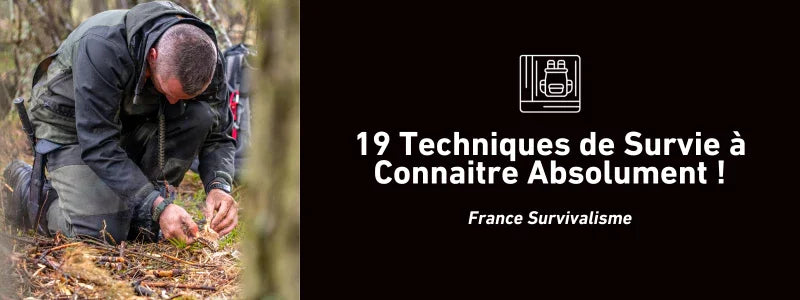#1 Make a Fire : One of the most important survival skills is the ability to start a fire without matches or a lighter. It is recommended to always carry three different types of lighting methods when hiking.
#2 Manage Panic : In an emergency, it is important to stay calm and think logically. The STOP rule (Stop, Think, Observe, Plan) can help in this situation.
No. 3 Build a Shelter : A shelter offers protection against bad weather, cold and animals. Recommended types include a “Sloped Shelter” or a “Debris Hut”.
#4 Build Traps : Traps can help obtain food by capturing animals. They operate passively and require little hardware.
#5 Build a Fishing Spear : A homemade spear can be an effective method for catching fish, a good source of protein.
#6 Find Edible Insects : Insects can be a good food source because they are rich in protein and fat. However, it is essential to know which insects are edible and how to prepare them correctly.
#7: Send a Distress Signal
If you are lost, it is essential to know how to create a distress signal. Build a large "SOS" or "X" out of stones or logs, and use a Morse signal with a flashlight or mirror.
No. 8: Make a rope
Making a rope is essential for many survival tasks. It's surprising that many hikers forget to bring a rope or cord, when it is possible to make a rope from plant fibers.
No. 9: Warm cold feet
It is important to know how to warm frozen feet to avoid serious frostbite. Never massage or rub frozen tissue, and do not thaw frozen limbs over a fire or in hot water.
No. 10: Measure the distance traveled
It's helpful to know how far you've traveled, especially without GPS. Use a watch to estimate distance or count your steps to calculate distance traveled.
No. 11: Determine the cardinal directions
Knowing the north is essential for navigation. Use an analog watch by pointing the hour hand toward the sun to find south, with north being the opposite.
#12: Stop bleeding
If you have a deep cut, knowing how to create a bandage with natural foam can be crucial to avoiding bleeding to death.
No. 13: Avoid insect bites
To avoid insect bites, find a windy location, cover exposed skin with mud and dirt, and avoid dark, damp, sweaty clothing.
No. 14: Make a Splint for a Broken Arm
If you break an arm in the wilderness, knowing how to create a splint with a sleeping mat or poles can be vital.
No. 15: Estimate the length of the remaining day
Knowing how much time is left before nightfall is crucial to planning your survival activities. A simple method is to use your fingers to estimate the time remaining until sunset.
No. 16: Know your water needs
Understanding your water needs is vital, especially in extreme situations. The average person can lose up to 1.5 liters of water per day, or even more during intense physical exertion or heat.
No. 17: Make a Solar Distiller
A solar still is an effective way to produce drinking water in survival conditions. It involves digging a hole and using a plastic sheet to condense the evaporated water.
No. 18: Know edible plants
Knowing how to identify edible plants is an essential skill. Common edible plants include dandelions, wild leeks, watercress, sorrel, nettles, chickweeds and rose hips. These plants provide important nutrients like vitamins, minerals and trace elements.
#19: Think positively
Attitude is the most important element in survival. People who keep a positive attitude and never give up are the ones who most often survive in the wild.
